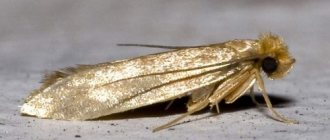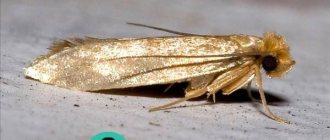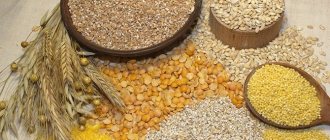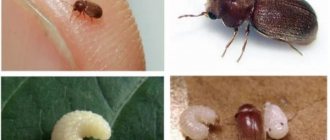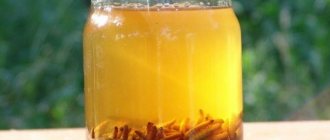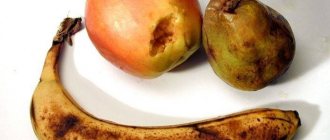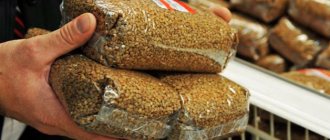Appearance
The fruit moth goes through several stages of development. In everyday life, a moth is usually called a nondescript moth of a gray, brownish color. The size does not exceed 3 cm with open wings. Butterflies are active in the dark, but you can periodically notice moths fluttering during the day.
Moth eggs are extremely small and almost impossible to notice with the naked eye. One female lays up to 100 pieces during the entire life cycle - 3-14 days under favorable conditions.
The larvae are white caterpillars or worms with a dark “muzzle”. The food inside is visible through the translucent covering of the body.
The moth larval phase ends with the formation of a cocoon, pupation. After 2-3 days, a moth appears. There are no significant differences in the appearance of females and males. The fruit moth is pictured below.
If there are worms in dried fruits, what to do - Doctor Bogdanov
A type of food moth is the fruit moth. Most often it can be found in dried fruits, but sometimes it is even found in tea. If there is a fruit moth, experienced housewives know how to get rid of it.
How to get rid
If the moth is already flying around the kitchen with all its might, and food is filled with its larvae, then urgent measures must be taken. There are various ways to get rid of fruit moths. The main thing is to act without delay.
As soon as larvae are noticed, the following measures must be taken immediately::
- All contaminated products must be disposed of without regret, since such dried fruits are no longer suitable for consumption and can even be dangerous.
- All drying storage containers must be treated with a vinegar solution.
- Shelves and cabinet walls with contaminated dried fruits are also treated with vinegar. This is necessary in order to get rid of eggs and larvae that may have ended up in crevices and hard-to-reach places.
When treating surfaces with vinegar solution, the housewife should protect her hands with rubber gloves from chemical burns. It is advisable to leave the vinegar solution on the surface for 30 minutes. This will completely destroy the pests.
But since vinegar has a strong unpleasant odor, the cabinets need to be thoroughly ventilated after treatment.
How to get rid of moths quickly and forever
Traditional methods
An experienced housewife has various folk methods in her arsenal on how to get rid of fruit moths in the kitchen. However, when fighting insects using traditional methods, it is important to remember that the pest gradually develops immunity to them. Therefore, they should be changed periodically in order to improve the results and preservation of dried fruits.
Getting rid of kitchen moths in the kitchen can be achieved with the following means::
- Lavender. This plant has a strong aroma that almost all insects cannot tolerate. You can sew fabric bags, fill them with dried lavender and place them in a drying cupboard. Or you can use dried mint or lemon balm.
- Bay leaf. Several leaves can be placed in habitats for winged insects. They will also repel pests, but experienced housewives note that laurel is less effective than lavender.
- Citrus. The zest of orange, tangerine, and grapefruit emits a strong aroma that repels pests. But the essential oils from them quickly evaporate, so the crusts need to be replaced with new ones from time to time.
But using folk methods to get rid of moths is rarely possible. They are more suitable for preventing the appearance of fruit butterflies.
Preventive methods
Methods that can be used to protect food from flying insects may include the following::
- Sticky tapes are hung around the kitchen. On the shelves of the cabinets there are traps and tablets suitable for the food area.
- With the arrival of cold weather, it is useful to leave the kitchen window open for 20 minutes every evening. Low temperatures have an adverse effect on moths and reduce their activity.
- In case of severe infestation of the premises, after the appearance of a large number of moths, insecticides can be applied. But before using them, all food supplies must be placed in airtight containers. Disinsection is carried out, and after 20 minutes the cabinets are ventilated. They are also additionally wiped with baking soda or laundry soap to eliminate the strong smell of insecticides.
An adult moth is easy to swat because it does not react quickly. However, this will not guarantee that the premises are free of pests.
How to preserve dried fruits
When moths appear, many people want to know how to get rid of them. But more experienced housewives prefer to figure out how to protect dried fruits from food moths.
The following preventive steps will help you learn how to protect and protect dried fruits from food moths::
- Products (dried fruits) should be stored in sealed glass or tin containers.
- Supplies must be periodically sorted out and heated in the oven for 5-6 minutes.
- Periodically thoroughly clean cabinets using a vinegar solution, and you can also use special repellents.
- Place special traps, tablets, cassettes against moths and their larvae next to cereals and dried fruits.
It is important not to miss the moment of infection. After all, when there are already a lot of moths flying around the kitchen, then most likely an impressive amount of dried fruit has already been spoiled
What does it look like
The fruit moth goes through several stages of development. A moth is usually called a gray or beige nondescript moth. Together with open wings, its size usually does not exceed 3 cm. More often, moths are active at night, but occasionally they can be found during the day.
Where does it come from?
The appearance of fruit moths in the house can be explained as follows::
- An insect enters through an open window. A moth flies towards the light. Indoors, it selects a suitable place to lay eggs and dies after 2-3 days. It is difficult to notice one moth. The fact that an infection has occurred becomes clear from the appearance of voracious larvae.
- During the drying process, pest eggs may end up on apples or pears. Over time, the drying material is placed in a dark place (cupboard, pantry), which is a favorable place for the development of the larvae.
- Sometimes fruit moths are brought into the house with store-bought products. If drying ends, the fruit moth can lay eggs in cereals, flour, tea, and nuts. The only things this parasite is not attracted to are coffee and spices.
Even closed containers and sealed bags may contain eggs, larvae or butterflies.
Features of the insect
The fruit moth lives for 4 weeks. During this time, the eggs develop for 72 hours, the moth flutters for 2 weeks, and the rest of the time is spent parasitizing the larvae, which cause great harm to humans. Moth eggs are small and very difficult to notice with the naked eye . During her life cycle, a female can lay up to 100 eggs.
https://www.youtube.com/watch?v=2nPpF-BaG3g
Moth worms look like white caterpillars with a dark “muzzle”. The body of the pest is translucent and the food inside is visible through it. The moth larval phase ends with the formation of a cocoon, pupation. After 2-3 days, a moth appears. Males and females are visually indistinguishable from each other.
Popular questions
Housewives often ask the following questions about fruit moths::
- Can you get poisoned if you eat dried fruits infected with moths? By the time the larva becomes an adult, it will have time to change its skin several times, and through its vital activity it will contaminate food. During this time, a lot of feces and old insect skin will accumulate in the dried fruit. If you eat a lot of such foods, food poisoning can occur with serious intoxication of the body.
- Will freezing help? It is not advisable to put food in the refrigerator, since under the influence of low temperatures the larvae of fruit moths simply fall asleep. If you return them to their familiar environment, they calmly come to life and begin their activities. Eggs and larvae die only at high temperatures.
- Are moths afraid of washing powder? Neither ordinary soap nor washing powder are harmful to fruit moths. It can even live in washing powder packets. She is only afraid of the vinegar solution. After treating with this product, the containers can be washed with a solution of laundry soap to remove the specific smell of vinegar.
Fruit moths are a serious pest. If you don’t fight it, it can ruin not only drying, but also neighboring products. This especially happens with large stocks designed for long-term storage. Experienced housewives recommend not making large reserves. It is enough to purchase dried fruits in quantities for 2 weeks.
If moths or larvae appear, immediate measures must be taken to eliminate them. There are many different ways to do this.
It is also important to adhere to preventive measures so that later you do not have to put a lot of effort into exterminating pests.
, please select a piece of text and press Ctrl+Enter. We will definitely fix it, and you will get + to karma
Ways to enter the house
An insect enters a person’s home in several ways. Sometimes the owner or housewife brings the pests themselves, but they notice the presence of living creatures in the house after about 2 weeks.
You can list several ways where moths come from in an apartment. How an insect gets into the house:
- Through open windows. The butterfly is active in the dark and is attracted by the light of evening windows and lanterns. It flies into a room, finds a suitable place to lay eggs, and dies a few days later. In most cases, one moth goes unnoticed; the owners learn about the infestation of the apartment after the appearance of voracious larvae.
- In the warm season, pest eggs may end up on apples and pears that people use for drying. Over time, dried fruits are placed in a dark place - a cabinet, closet, pantry, cardboard box, and this is a favorable place for the development of larvae.
- Fruit moths are brought into the house with food from the store. Moths do not always live in dried fruits. In the absence of these products, the moth lays eggs in cereals, flour, tea, and nuts. The moth actively feeds on these products. Only coffee and spices are not attractive. Even in closed containers or sealed bags there may be eggs, larvae and butterflies.
The life cycle of the fruit moth does not exceed 30 days, of which the eggs develop for three days, the butterfly flutters for only 14 days, the rest of the time is spent parasitizing the larvae, which pose great harm to humans.
Moth in fruit
Protection of dried fruits
If moths have already laid eggs in pieces of fruit, the product will have to be thrown away. It will be necessary to carefully examine the grain, flour, pasta, and cereals standing nearby, since food moths and its varieties can also be found there: flour, fruit, grain. If worms are crawling in some of these products, all these packages must also be thrown away.
Read also Orris root medicinal properties
If there are few larvae, you can fight for food. Like all insects, moths are afraid of low or high temperatures. Therefore, dried fruits, carefully selecting spoiled slices, need to be dried in an oven heated to 70 degrees for half an hour.
You can also kill moths and their larvae with frost: simply take dried fruits out onto the balcony in winter or leave them in the freezer overnight.
Food moths and their larvae prefer high humidity and warmth. It is difficult to take her out of a home where conditions suitable for her are maintained. The ideal way to get rid of moths is through thorough ventilation, drying corners, and eliminating damp foods.
Sometimes housewives prefer to use chemicals, but this method will not get rid of moths for long. Knowing how to deal with food moths, you can protect your supplies from voracious pests and cook apple compote for your children all winter.
Knowing how to deal with food moths, you can protect your supplies from voracious pests and cook apple compote for your children all winter.
Fruit moth is a type of food moth. The insect lives for about a month, and stays in the form of a butterfly from 3 to 14 days. The pests are carried out by moth larvae - voracious caterpillars that eat any food supply, not just fruit. In nature they are found on fruit trees, hence the name. Active in the warm season.
Fighting methods
There are several ways to get rid of moths in dried fruits and other contaminated products. The main control methods are aimed at destroying the larvae, but butterflies should not be left without attention.
If there is a moth in dried fruit, its presence can be detected by the presence of white caterpillars of different sizes, grains from the chewed mass, and cobwebs. At the same time, small moths may periodically flutter around the kitchen. How to get rid of moths in dried fruit depends on the degree of infestation.
- Sort through the dried fruits, place on a baking sheet, and roast in the oven for a few minutes. In this way, eggs are destroyed, larvae, and butterflies are removed manually.
- After a thorough inspection, sort out the dried fruits and place them in places with bright sunlight. In this way, unfavorable conditions are created for the development of fruit pest larvae.
- In case of severe infection, it is easier to throw the dried fruits along with the container outside into the trash can. If food was stored in a cloth bag, it can be washed in hot water to destroy pest eggs.
To get rid of fruit moths completely, it is necessary to exterminate the butterflies and create unfavorable conditions for laying eggs. To get rid of moths in the kitchen, cabinets where infected dried fruits were stored are treated with folk remedies for moths: wiped with water with the addition of table vinegar, ammonia, and lavender essential oil.
To prevent re-infestation of the fruit pest, it is necessary to review all food supplies. Fruit moths can lay eggs in cereals, flour, tea, dry medicinal herbs, nuts, and cocoa. Avoids only coffee and spices.
Destruction of moths
Methods for killing moths
The moth is not distinguished by its quick reaction or strong flight abilities. It's easy to slam him. But there is no guarantee that this is the only or last butterfly in the room, so you should play it safe and use effective moth repellents in the apartment and in the kitchen in particular.
- Sticky tapes are hung around the kitchen, anti-moth tablets and special traps are used in cabinets.
- Among the folk remedies, herbs such as lavender, peppermint, chamomile, and geranium will help repel the pest. These plants repel moths with their scent. Orange peels and garlic are also excellent repellents.
- Ventilating the kitchen for 20 minutes every evening during cold periods reduces the activity of moths and creates unfavorable living conditions for them.
- In case of severe infestation of the premises, aerosols and moth sprays are used. Initially, they carry out cleaning to destroy the larvae, wipe down the cabinets, and hide the food in airtight containers. Disinsection is carried out. Use any insecticidal agent - Raptor, Raid, Antimol, Clean House, Dichlorvos. After 20 minutes, ventilate, carry out wet cleaning by adding baking soda and laundry soap to the water. An alkaline environment completely neutralizes the effect of the insecticide.
Destruction
Of course, the surest thing would be to simply destroy both the adult moths and their larvae. But only chemicals - insecticides - have this effect, and their use and even storage with food is strictly prohibited. The toxic effect of moth repellents can lead to poisoning and other sad consequences for humans.
Only special traps can be considered safe. Inside the trap there is a sticky liner and a special filler that emits an aroma that attracts moths. Insects flock to the seductive smell and become tightly glued. Your task is only to change the adhesive liners on time.
Prevention methods
Preserving dried fruits from moths at home is quite difficult, but if you wish, you can avoid troubles.
- Store dried fruits in places with bright sunlight or in a room with low temperatures.
- Periodically sort through the supplies and heat in the oven for a few minutes.
- Wipe cabinets with water and vinegar or place repellents. The moth is afraid of a pungent odor, but with constant presence it gets used to it, so protection should be alternated.
- Place special traps, tablets, cassettes against moths and their larvae next to dried fruits.
You need to begin active actions immediately after discovering at least one moth or caterpillar. Knowing what moths are afraid of, you can quickly eliminate the problem. Otherwise, all food supplies will be contaminated, which will then have to be thrown away. Due attention should be paid to proper storage of dried fruits.
Dried fruit compote is very healthy and is an excellent alternative to packaged juices, which are usually full of dyes, preservatives and sugar. Therefore, those who care about their health always have dried apples, pears, dried apricots and other fruits in their homes. But if you store them incorrectly, you may be in for an unpleasant surprise: one fine day, a flying insect appears in the closet - a fruit moth.
Features of the insect
Getting rid of fruit moths is difficult - this voracious insect is not so easy to detect at the very beginning. The fact is that adults are already flying around the kitchen, but they don’t eat anything at all. Their main goal is to find a secluded place and lay eggs there, from which moth larvae will hatch in a few days. It is they who turn delicious dried fruits into real dust.
You can recognize fruit moths by the characteristic stripes on the tips of their wings. It is small in size, only about 1 cm long. Look at what the fruit moth looks like in the photo, so that if it appears, you can identify the enemy by the appearance of the moth butterfly. The grown larvae can be seen with the naked eye; they do not look like small worms. They hatch from eggs hidden in a cocoon, as if made from a cobweb.
food moth
Fruit moths can appear not only in dried fruits. An excellent habitat for it are bags of cereals or flour. Moth larvae prefer to eat sweet fruits, but the butterfly can lay eggs in a dry place next to them, and the hatched larvae will crawl to the delicacy on their own.
Fortunately, they do not crawl long distances, so fruit moths can appear in an apartment only in one of the following ways:
- fly through the ventilation ducts and settle in the food cupboard;
- entering the house with a new batch of low-quality dried fruits;
- fly into an open window, especially in the evenings when the lights are on in the windows.
Therefore, it is quite possible to protect yourself from its appearance and it is much easier to do than getting rid of moths in dried fruits.
How do fruit moths get into the house?
Fruit moths can appear even in a clean house, where no other harmful insects live. There are several ways to enter a home from outside, for example:
- a butterfly flies into a room through an open door, window or window in the warm season;
- through the ventilation system;
- when purchasing contaminated products: if you buy dried fruits with larvae, the worms will infect new supplies in the cupboard, and then turn into adult butterflies that continue to reproduce in the house.
Therefore, everyone can face the problem of damage to dried fruits by insect larvae. The risk is especially great in the warm season.
How to store dried fruits
If you store dried fruits correctly, the chances of them being spoiled by fruit moths can be practically reduced to zero. You definitely can’t dump everything into one big pile or wrap it in a plastic bag. These are ideal conditions for mold and dried fruit will spoil so quickly. Small moth larvae can crawl through even a very small hole, which is completely unnoticeable, but after a while it turns out that all the food is spoiled
Following these rules will help you preserve dried fruits from moths at home:
- It is better to store freshly purchased ones separately at least for the first time - send them to a kind of quarantine;
- for storing dried fruits, glass or metal containers with a tight lid are best (line the metal bottom with paper!);
- once every 7-10 days in containers with dried fruits and if cocoons, larvae or adult moths are found there, throw away everything that was in the container and process it thoroughly.
In summer, you can store dried fruits in wooden boxes on the balcony - the pest does not like sunlight and air currents, so such conditions are completely unsuitable for it. At the same time, the dried fruits will dry out, removing any moisture that may have accumulated during home storage.
If there are moths in dried fruits, then even after you have removed all the spoiled ones, you will have to make it a rule to carefully inspect the remaining undamaged products before consuming them. You may not have noticed fruit moth eggs or newly formed larvae. But they will grow up and the insect will continue the reproduction cycle.
How to store dried apples to prevent moths. Preparing dried fruits for storage
You can check the readiness of dried fruits by squeezing a handful of this product in your fist and rubbing it a little with your fingers.
If dried fruits crumble easily, then they are ready for long-term storage.
But if, after compression, they stick together to form a lump, then the heat treatment must be continued.
First, not completely dried fruits are kept in the open air for 24 hours, and then sent to the oven (temperature should be 60-80 °C) for 60 minutes.
You should consider how to store dried apples to prevent moths or other varieties of dried fruits, since they all have their own moisture index.
It is not advisable to store different fruits together. However, apples and pears do well when stored together.
Selection of containers
Dried fruits that have undergone proper heat treatment are stored safely and for a long time in glass containers with a tight-fitting lid. If vacuum lids are used, then dried fruits can be stored for several years, since the lack of oxygen does not allow pathogenic microorganisms to multiply.
Glass containers are indicated for fruits with a high sugar and moisture content, for example:
- dates;
- prunes;
- dried apricots;
- raisin.
Plastic containers are acceptable for storage, but are undesirable because drying there becomes damp and mold appears on it.
It is not recommended to store dried fruits in plastic bags, as condensation often forms in them, which promotes rotting and mold formation.
In dried apples you can see not only food moths, but also bugs and sugar mites, so they should be stored correctly in cardboard boxes, bags made of thick fabric, glass containers with lids, and plywood boxes. All of them block access for small insects.
Deciding on storage location
Heat and high humidity are the main enemy of dried fruits. Industrial producers store dried fruits in dark rooms with good air circulation at a temperature of 2-10 °C.
In residential premises, creating such storage conditions is quite problematic, so housewives sometimes do not know how to properly store the dryer.
Hermetically sealed glass jars with a dryer are best placed in the pantry or on a separate shelf in the kitchen cabinet, where they are least likely to be looked at. And also this place should be away from the stove or heat appliances.
Some types of dried fruits can be stored in the refrigerator.
But this option is not suitable when the housewife thinks about how to preserve dried apples from moths.
If you need to preserve dried apricots, raisins, prunes, dried peaches or pears, then they can be placed on the bottom shelf of the refrigerator, where they will remain soft longer and will also be protected from moths or other pests.
How to fight moths
There are a lot of means to combat fruit moths. Moreover, here, not industrial methods, which contain poison that is harmful to humans, are better suited, but folk methods. But first of all, you need to empty all the cabinets and carefully double-check all the contents.
Folk remedies for moths
After all damaged products have been thrown away and properly packaged into new ones, you must thoroughly wash all surfaces of the cabinet (not just the shelves!) with regular food vinegar diluted in half with water. Particular attention should be paid to the far corners and the back surface of the shelves - this is where fruit moths most often lay cocoons with eggs.
Then you need to put on the shelves the products that fruit moths really don’t like:
- dried orange or tangerine peels;
- bags of spices: allspice, coriander, cinnamon;
- dry bay sprigs or bags with leaves;
- bags with herbs: lavender, mint, wormwood, oregano;
Moreover, it must be taken into account that all these folk remedies for moths do not kill, but only repel the insect and over time the larvae can adapt to them. Therefore, in order to guarantee the preservation of products, it is better to alternate them approximately once every 2-3 months.
It is useful to place an open container of salt in the cupboard. It will absorb excess moisture, creating a microclimate that is too dry for moths. At the same time, salt will fight the appearance of mold and prevent dried fruits from becoming damp. Following these simple rules will reliably protect your home from fruit moths, and you will always be able to enjoy your favorite delicacies.
A small butterfly flying through your kitchen is a serious enough reason to start worrying about the safety of your food. Most often, parasites feed on cereals and grains; moths are also often found in dried fruits. These insects feed while at the caterpillar stage, making small holes in dried fruits and entangling themselves in a silk cocoon.
How to get rid of fruit moths? Ways to fight
Fruit moths (larvae) in dried fruits
The fight against fruit moths is complicated by one important point - you cannot use chemical insecticides. If, for example, you have bed mites in your house, then it is enough to use special chemicals and clean it. But fruit moths live in food, so this method is excluded.
So what should you do to get rid of moths? A good option would be to use special traps and adhesive tapes. They need to be placed in fruit moth habitats: next to cabinets, pantries, shelves where you store grains, dried fruits, and nuts.
Of course, such traps will help reduce the number of insects in the house, but there is no guarantee that you will be able to get rid of them forever.
As soon as you notice that fruit moths have appeared in the house, you need to immediately get rid of all contaminated products. Sort out fruits, vegetables, dried fruits, nuts, grains, etc. Contaminated foods should not be eaten, as they can be dangerous to humans.
All containers in which you stored contaminated food should be washed thoroughly and treated with a vinegar solution. To protect your skin from vinegar burns, you should wear gloves. The solution should be left for at least half an hour. Vinegar has an unpleasant and pungent odor, so after processing you need to ventilate the room well.
We also recommend running a vinegar solution over the shelves and cabinets, as the larvae could get into the cracks. This step will prevent any new food you put in your cabinets from becoming contaminated.
Folk remedies for fighting fruit moths
Simple folk remedies can also help in the fight against insects, many of which are found in every home.
To combat moths you can use:
- Lavender. The strong aroma of this herb repels all butterflies. To protect food from fruit moths, you can place dried lavender in cabinets.
- Mint and lemon balm. The sharp, refreshing aroma is also not to the taste of the fruit moth. These herbs can be used in a similar way to lavender.
- Bay leaf. It is enough to lay it out in the closet, and fruit moths will leave your home. Bay leaf is not as effective as lavender, but it has the advantage of being readily available.
- Citrus. Orange, lime, lemon, and grapefruit have a strong aroma that will also help repel fruit moths. To control insects, place peels in cabinets where food is stored. The disadvantage of this method is that the smell quickly disappears, so you need to constantly replace the crusts with fresh ones.
- Garlic. It has a sharp and unpleasant odor that repels moths. Place fresh, peeled garlic cloves in your cabinets.
- Salt. Salt absorbs excess moisture and creates a dry microclimate unsuitable for fruit moths. In addition, salt will help prevent mold and prevent dried fruits from becoming damp. You need to pour salt into open containers, for example, saucers, and place them in cabinets.
Please note that over time, insects develop immunity to folk remedies, so for greater effectiveness they need to be changed.
By the way, good news for gardeners: all types of geranium have a high content of essential oils, which repel fruit moths. Pelargonium will not only decorate your home and give it a pleasant aroma, but will also help in the fight against insects.
External characteristics
If you have observed repeated appearances of butterflies over the course of three weeks, this is evidence that the infestation is quite serious and it is necessary to immediately take steps to eliminate the insects.
The winged moth is no longer capable of causing any harm, since their oral organ is reduced upon reaching sexual maturity. Parasites are their larvae, which, having powerful jaws, feed quite intensively and accumulate energy reserves so that upon reaching the adult stage they have the opportunity to reproduce.
Interesting fact! The absence of a proboscis is due to the fact that, upon reaching sexual maturity, the moth loses not only the ability to feed, but also to digest food. Therefore, they simply do not need this organ.
The caterpillar's head is brown. As a rule, infestation of dried fruits and vegetables with this type of moth will be indicated by small, neat nests and a thin cobweb around them. The larva will be inside the nest.
Kinds
Depending on certain food preferences, as well as the characteristics of localization, life activity, and color, food moths are divided into several main subspecies, the main ones of which are the following:
- Flour moth or moth. This is the most unpretentious type of insect, common in ordinary apartments.
- Kitchen moth or cocoa moth. This species is especially often confused with the clothes one, which is due to the specific coloring - the wings of such insects have a light yellow tint.
- Fruit moth. As the name suggests, the larvae of this insect prefer to eat dried fruits and fresh fruits. This butterfly is also a garden pest.
- Barn fire. This insect is often found in large granaries. It is especially difficult to destroy.
All types of food moths share food preferences, namely: their food sources are groceries, flour, sugar, cookies, dried bread, and more.
Actions to take when a pest is first detected
Moths do not appear on their own. Most often, you yourself bring it into your home with food; less often, an adult may fly into a window or an open door. As a rule, contamination occurs as a result of violation of the storage conditions of the product, and this can happen both in the factory warehouse and in the store itself.
- If you purchase dried fruits in original packaging, then carefully check its integrity before purchasing. If you find even one minor hole, set the product aside.
Advice! The easiest way to check the factory container for damage is as follows: squeeze it in your hands, and if it begins to gradually deflate, it means the seal is broken.
We talked in detail about moths in cereals and the fight against them in a separate article: How to get rid of cereal moths?
Advice! Do not purchase dried fruits at bargain prices, as quite often the seller tries to sell the contaminated goods at a discount.
Fighting methods
To destroy food moths, first of all, you should pay attention to gentle methods. It is not recommended to immediately use insecticides in the kitchen, as there is a possibility of the chemical getting on food. First, try traditional methods that can not only get rid of pests, but also prevent their reappearance.
Heat treatment
Once you have discarded all contaminated dried fruit, the remaining fruit can be heated at relatively high temperatures. To carry out this operation, the fruits are freed from packaging and laid out on a baking sheet. Set the temperature in the oven to no less than 50°C and no more than 70°C and heat the product for 3 hours.
At the end of the procedure, the fruit must be placed in glass containers with a hermetically sealed lid and put in the refrigerator or on a shelf in a cabinet. When you notice that adults stop appearing, the products can be returned to their permanent storage location.
Using improvised means
For the second method you will need:
- soap solution;
- table vinegar;
- lemon, eucalyptus or peppermint essential oil;
- Bay leaf.
The process sequence is as follows:
- completely empty wall cabinets, bedside tables and pantry of food and any objects;
- using a small vacuum cleaner attachment, treat the interior surfaces of the cabinets;
- Using a soft sponge soaked in a hot soapy solution, wipe the shelves, doors, hinges and corners of the furniture;
- containers intended for dried fruits must also be treated with soap and water;
- dry everything thoroughly and wipe with vinegar, to which you should first add a few drops of essential oil;
- Place a bay leaf on the bottom of each container.
Primary requirements
For most types of dried fruit, be it raisins, dates, dried apricots or apples, general storage rules apply
To begin with, it is important to choose the right temperature regime at which the product will be preserved at home. Optimal temperatures are +10…12 ℃
Finding such a place in a residential building or apartment is quite difficult.
Experienced housewives advise placing dried fruits in a closed kitchen cabinet, located closer to the floor and away from kitchen appliances that emit heat. A cool pantry or glassed-in balcony is also suitable for saving.
Air temperature and humidity
Dried fruits with a moist structure (for example, prunes) can be stored in the refrigerator at a temperature of +6 ℃.
But well-dried or crispy fruits should not be kept in the refrigerator, otherwise they will quickly become damp and lose their original qualities. How long will the workpiece last in a cold place? The shelf life of dried fruits at the specified temperature is 3-4 months.
An equally important indicator that affects the shelf life of dried fruits is air humidity. To establish the optimal level of moisture in the storage area, start from the moisture content of the fruits themselves, which averages 17-25% (with the exception of wetter prunes). Such products are best preserved at an air humidity of 60-70%. It is in such conditions that dried apricots, raisins and other types will not dry out or, conversely, get wet. Prunes can be stored at higher humidity.
Dried apricots are perfectly stored in fabric bags on a dark shelf in a kitchen drawer
Tara
In order for dried fruits to retain their taste for a long time and remain healthy for many months, you need to choose the right storage container. This should be a high-quality sealed container that minimizes air access to the product. Give preference to small wooden barrels, glass or ceramic jars with screw-on lids. Plastic containers with a tight-fitting lid are well suited for such purposes.
Store different types of dried fruits in separate containers. Give preference to glass or ceramic jars with tight lids
If you need to store several types of dried fruits, immediately prepare separate containers for them. Under no circumstances should you save dried apricots or raisins together with prunes, because they will quickly absorb excess moisture and the specific smell of dried plums.
If you want to make a mixture of dried fruits, dry them in the oven first to even out the moisture level in all the fruits. If desired, you can add nuts, honey, seeds to the preparation and grind the ingredients.
The mixture of dried fruits and honey is usually stored in a glass container in the refrigerator.
Types of dried fruits such as dried bananas, kiwi, apple chips, candied pineapple are perfectly stored in fabric or canvas bags. To prevent the product from getting damp indoors, place a container of salt or rice next to it, which will absorb excess moisture.
Prevention
Having completely gotten rid of moths in dried fruits, you need to think about preventive measures. To prevent the parasite from returning to your kitchen, you can do the following:
- try to constantly maintain perfect cleanliness in the kitchen, which will prevent the appearance of not only moths, but also other insects;
- store food only in closed glass containers;
- it is better to cover hoods and vents with mesh to avoid the penetration of parasites from neighboring apartments;
- When you come home from the store, always check your food products - sort through dried fruits, add grains.
Now you know how to recognize fruit moths, remove them and prevent their reappearance. Remember that food parasites will only fly in the kitchen. If you notice small butterflies in the closet, then this is a completely different type of pest, which you can learn about from other articles on our website. For example, if you want to protect your winter wardrobe from small pests, we recommend reading the article: What means can you use to protect your fur coat from moths?
How to prevent moths from appearing
To prevent insects from multiplying and spoiling food, you need to take a few simple measures.
- All products should be stored in hermetically sealed containers or tightly tied bags. In this case, access to them will be closed and the insects will not be able to lay eggs and will soon disappear, even if they flew into the house.
- You can place pots of fragrant geraniums on the kitchen windows. This houseplant has a pungent odor that most insects dislike. In houses where geranium blooms, food moths rarely appear. In the same way, you can plant lemons on the windows, the smell of which moths cannot stand.
- It is necessary to periodically audit stocks and ruthlessly get rid of suspicious packages. For preventive purposes, cabinets should be wiped with a vinegar solution from time to time.
- It is best to cover all windows and ventilation holes with nets.
It is possible to get rid of food moths and it is not so difficult. A useful habit - closing food and periodically cleaning cabinets helps you forget for a long time about what this unpleasant creature looks like. This article will tell you how to defeat grain moths.

